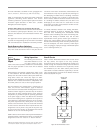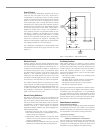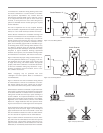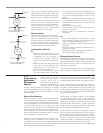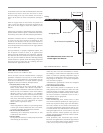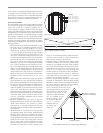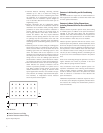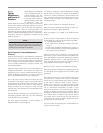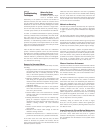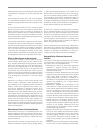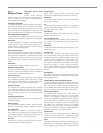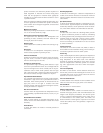
SYSTEM SENSOR
Addressable System Smoke
Detector
System smoke detectors,
which, in addition to providing alarm and trouble indica-
tions to a control unit, are capable of communicating a
unique identification (address).
Air Sampling-type Detector
A sampling-type detector consists of piping or tubing distri-
bution from the detector unit to the area(s) to be protected.
An air pump draws air from the protected area back to the
detector through the air sampling ports and piping or tub-
ing. At the detector, the air is analyzed for fire particulate.
Alarm (Signal) Notification Appliance
An electromechanical appliance that converts energy into
audible or visible signal for perception as an alarm signal.
Alarm Signal
A signal indicating an emergency requiring immediate
action, such as an alarm for fire from a manual box, a
waterflow alarm, or an alarm from an automatic fire alarm
system, or other emergency signal.
Alarm Verification Feature
A feature of automatic fire detection and alarm systems to
reduce unwanted alarms, wherein automatic fire detectors
must report alarm conditions for a minimum period of time
or confirm alarm conditions within a given time period,
after being reset, to be accepted as a valid alarm initiation
signal.
Annunciation
A visible and/or audible indication of system status.
Automatic Fire Alarm System
A system of controls, initiating devices and alarm signals in
which all or some of the initiating circuits are activated by
automatic devices such as smoke detectors.
Class A Circuit (Loop)
An arrangement of supervised initiating device, signaling
line, or indicating appliance circuits that prevents a single
open or ground on the installation wiring of these circuits
from causing loss of the system’s intended function.
Class B Circuit (Loop)
An arrangement of supervised initiating device, signaling
line, or indicating appliance circuits, which does not pre-
vent a single open or ground on the installation wiring of
these circuits from causing loss of the system’s intended
function.
Combination Smoke Detector
A smoke detector that combines two or more smoke or fire
sensing technologies.
Detector Coverage
The recommended maximum distance between adjacent
detectors or the area that a detector is designated to protect.
Drift Compensation
The capability of a detector to automatically adjust its
alarm sensitivity to compensate for any changes over time
in the factory settings for smoke and/or fire detection. In
analog systems, this may be done by the panel.
End of Line
A device such as a resistor or diode placed at the end of a
Class B wire loop to maintain supervision.
Appendix 1
Glossary of Terms
End of Line Relay
Device used to supervise power (for four-wire smoke
detectors) and installed after the last device on the loop.
False Alarms
An unwanted alarm caused by non-smoke contaminants
such as dust or insects.
Fire
A chemical reaction between oxygen and a combustible
material where rapid oxidation results in the release of
heat, light, flame and/or smoke.
Flame Detector
A device that detects the infrared, ultraviolet, or visible
radiation produced by a fire.
Four-wire Smoke Detector
A smoke detector which initiates an alarm condition on
two separate wires (initiating loop) apart from the two
power leads.
Heat Detector
A device that detects abnormally high temperature or rate-
of-temperature rise.
Initiating Circuit
A circuit which transmits an alarm signal initiated manu-
ally or automatically, such as a fire alarm box, smoke, heat,
or flame sensing device, sprinkler waterflow alarm switch
or similar device or equipment to a control panel or any
similar device or equipment which, when activated, caus-
es an alarm to be indicated or retransmitted. An Initiating
Device Circuit (Loop) is a circuit to which automatic or
manual signal initiating devices are connected where the
signal received does not identify the individual device
operated.
Initiating Device
Any manually operated or automatically operated equip-
ment which, when activated, initiates an alarm through an
alarm signaling device.
Intelligent (Analog, Smart) System Smoke Detector
A system smoke detector capable of communicating infor-
mation about smoke conditions at its location to a control
unit. This type of detector typically communicates a
unique identification (address) along with an analog (data)
signal, which indicates the level of smoke at its location.
Ionization Smoke Detector
An ionization smoke detector has a small amount of
radioactive material that ionizes the air in the sensing
chamber, thus rendering it conductive and permitting a
current to flow between two charged electrodes. This gives
the sensing chamber an effective electrical conductance.
When particles of combustion enter the ionization area,
they decrease the conductance of the air by attaching
themselves to the ions, causing a reduction in mobility.
When the conductance is less than a predetermined level,
the detector responds in a fire alarm condition.
Light Scattering
The action of light being reflected and/or refracted by
smoke particles for detection by a photoelectric smoke
detector. The action of light being refracted or reflected.
Listed
Equipment or materials included in a list published by an
organization (e.g., Underwriters Laboratories) acceptable
to the “authority having jurisdiction” and concerned with
17



